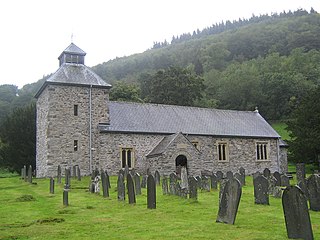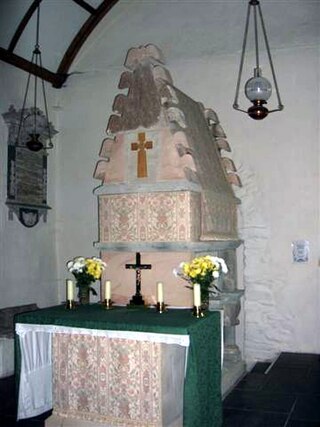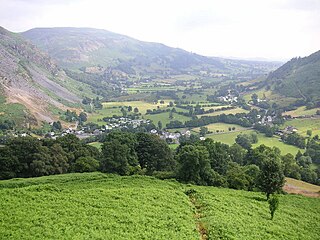Related Research Articles

Taliesin was an early Brittonic poet of Sub-Roman Britain whose work has possibly survived in a Middle Welsh manuscript, the Book of Taliesin. Taliesin was a renowned bard who is believed to have sung at the courts of at least three kings.

The Kingdom of Powys was a Welsh successor state, petty kingdom and principality that emerged during the Middle Ages following the end of Roman rule in Britain. It very roughly covered the northern two-thirds of the modern county of Powys and part of today's English West Midlands. More precisely, and based on the Romano-British tribal lands of the Ordovices in the west and the Cornovii in the east, its boundaries originally extended from the Cambrian Mountains in the west to include the modern West Midlands region of England in the east. The fertile river valleys of the Severn and Tern are found here, and this region is referred to in later Welsh literature as "the Paradise of Powys".

Meifod, formerly also written Meivod, is a small village, community and electoral ward seven miles (11 km) north-west of Welshpool in Montgomeryshire, Powys, Wales, on the A495 road and located in the valley of the River Vyrnwy. The River Banwy has a confluence with the Vyrnwy approximately two miles (3.2 km) to the west of the village. The village itself had a population of 317. The community includes the village of Bwlch-y-cibau and the hamlet of Allt-y-Main.

Cyfraith Hywel, also known as Welsh law, was the system of law practised in medieval Wales before its final conquest by England. Subsequently, the Welsh law's criminal codes were superseded by the Statute of Rhuddlan in AD 1284 and its civil codes by Henry VIII's series of Laws in Wales Acts between 1535 and 1542.

Bleddyn ap Cynfyn, sometimes spelled Blethyn, was an 11th century Welsh king. King Harold Godwinson and Tostig Godwinson installed Bleddyn and his brother, Rhiwallon, as the co-rulers of kingdom of Gwynedd on his father's death in 1063, during their destruction of the kingdom of their half-brother, king Gruffydd ap Llywelyn. Bleddyn became king of Powys and co-ruler of the Kingdom of Gwynedd with his brother Rhiwallon from 1063 to 1075. His descendants continued to rule Powys as the House of Mathrafal.
Cyngen ap Cadell or also (Concenn), was King of Powys from 808 until his death in 854 during a pilgrimage to Rome.

Brochwel son of Cyngen, better known as Brochwel Ysgithrog, was a king of Powys in eastern Wales. The unusual epithet Ysgithrog has been translated as "of the canine teeth", "the fanged" or "of the tusk".

Powys Fadog was the northern portion of the former princely realm of Powys. The princes of Powys Fadog would build their royal seat at Castell Dinas Brân, and their religious center at Valle Crucis Abbey. Some of its lordships included those of Maelor, Mochnant, Glyndyfrdwy, Yale, and Bromfield and Yale. Following the division of Powys, their cousin branch, the princes of Powys Wenwynwyn, would build Powis Castle.

The Bishop of St Asaph heads the Church in Wales diocese of St Asaph.

Gwrtheyrnion or Gwerthrynion was a commote in medieval Wales, located in Mid Wales on the north side of the River Wye; its historical centre was Rhayader. It is said to have taken its name from the legendary king Vortigern. For most of the medieval era, it was associated with the cantref of Buellt and then Elfael, small regional kingdoms whose rulers operated independently of other powers. In the Norman era, like the rest of the region between Wye and Severn it came to be dominated by Marcher Lordships.

Ial or Yale was a commote of medieval Wales within the cantref of Maelor in the Kingdom of Powys. When the Kingdom was divided in 1160, Maelor became part of the Princely realm of Powys Fadog, and belonged to the Royal House of Mathrafal. Yale eventually merged with another commote and became the Lordship of Bromfield and Yale, later a royal lordship under the Tudors and Stuarts.

St Melangell's Church is a Grade I listed medieval building of the Church in Wales located in the former village of Pennant Melangell, in the Tanat Valley, Powys, Wales. The church was founded around the 8th century to commemorate the reputed grave of Melangell, a hermit and abbess who founded a convent and sanctuary in the area. The current church was built in the 12th century and the oldest documentation of it dates to the 13th century. The building was renovated several times, including major restoration work in the 19th and 20th centuries. In the 1980s the church was in danger of demolition, but under new leadership it was renovated and a cancer ministry was started. In 1958, and again between 1987 and 1994, the site was subject to major archaeological excavations, which uncovered information about prehistoric and medieval activity at Pennant Melangell, including evidence of Bronze Age burials.

Melangell was a Welsh hermit and abbess. She possibly lived in the 7th or 8th century, although the precise dates are uncertain. According to her hagiography, she was originally an Irish princess who fled an arranged marriage and became a consecrated virgin in the wilderness of the Kingdom of Powys. She supernaturally protected a hare from a prince's hunting dogs, and was granted land to found a sanctuary and convent.

Cyfeiliog was a medieval commote in the cantref of Cynan of the Kingdom of Powys. Cynan also contained the commote of Mawddwy. Other sources refer to Cyfeiliog as a cantref in its own right, possibly as a result of Cynan being renamed for the largest commote within it.

Bryneglwys is a village and community in Denbighshire, Wales. The village lies to the northeast of Corwen on a hill above a small river, Afon Morwynion, and is situated in the ancient commote of Iâl (Yale). The community covers an area of 9.45 square miles (24.5 km2) and extends to the top of Llantysilio Mountain. It had a population of 369 at the time of the 2011 census, an increase from 344 during the 2001 census.

St Beuno's Church, Bettws Cedewain lies within the historic county of Montgomeryshire in Powys. The church occupies a prominent position overlooking the village of Bettws Cedewain, on the northern edge of the valley of the Bechan Brook which flows into the River Severn. Bettws is about 9 miles to the south-west of Welshpool. The church is a single-chambered structure with a western tower, set in a near-circular churchyard. A campanile or bellcote was added to the earlier tower in the early 16th century by the vicar, John ap Meredyth, whose memorial brass remains in the church to-day. The church was extensively rebuilt in 1868 under the supervision of the architect William Eden Nesfield. This included a complete rebuild of the upper part of the tower

Nannau is a Georgian mansion and estate near the village of Llanfachreth, Gwynedd, North Wales, UK. The mansion was initially inhabited by the Welsh Nanney (Nannau) family, who were direct descendants of the Kings of Powys. For over 900 years, the Nannau estate was in possession of the same family.

The Tanat Valley is a large valley in northern Powys, Wales, formed by the course of the Afon Tanat and its tributaries. Situated south of the Berwyn range, the valley forms from at Llangynog from the merger of two narrow valleys, the Cwm Pennant and Cwm Rhiwarth. Various historic sites, including the Iron Age hillfort Llwyn Bryn-Dinas and the medieval St Melangell's Church are located along the valley. Largely agrarian, sheep farming has formed a major industry in the region for several centuries. Large-scale slate and lead mining in the region lasted from the 16th to late 20th century, although earlier mines possibly existed during the Iron Age.
References
- ↑ Ralegh Radford & Hemp 1959, p. 83
- ↑ Pryce 1994, p. 29
- ↑ Pryce 1994 , pp. 39–40
- ↑ Pryce 1994 , p. 40
- ↑ Pryce 1994 , p. 23
- ↑ Pryce 1994 , pp. 29–30
- 1 2 Pryce 1994 , p. 28
- ↑ Stephenson 2017 , pp. 3–5
- ↑ Ralegh Radford & Hemp 1959 , p. 82
- ↑ Heaton & Britnell 1994 , pp. 103–104
- ↑ Pryce 1994 , pp. 35–36
- 1 2 Pryce 1994 , pp. 24–25
- ↑ Pryce 1994 , pp. 25–26
- ↑ Pryce 1994 , p. 25
- ↑ Huws 2022 , pp. 559–560
- 1 2 Pryce 1994 , p. 24
- ↑ Huws 2022 , pp. 158–159
- ↑ Huws 2022
- ↑ Pryce 1994 , pp. 33–34
- ↑ Pryce 1994 , pp. 31–32
- ↑ Cartwright 2002 , p. 7
- ↑ Cartwright 2013 , pp. 59–60
- ↑ Herbert McAvoy 2010 , p. 211
Bibliography
- Cartwright, Jane (2002). "Dead Virgins: Feminine Sanctity in Medieval Wales". Medium Ævum . 71 (1): 1–28. doi:10.2307/43630386. ISSN 0025-8385. JSTOR 43630386.
- Cartwright, Jane (2013). Mary Magdalene and Her Sister Martha: An Edition and Translation of the Medieval Welsh Lives . The Catholic University of America Press. ISBN 9780813221892.
- Heaton, R. B.; Britnell, W. J. (1994). "A Structural History of Pennant Melangell Church". Montgomeryshire Collections . 82: 103–126. hdl:10107/1271085. ISSN 0144-0071.
- Herbert McAvoy, Liz (2010). "Anchorites and medieval Wales". Anchoritic Traditions of Medieval Europe. Boydell & Brewer. pp. 195–216. doi:10.1515/9781846157868. ISBN 9781846157868.
- Huws, Daniel (2022). A Repertory of Welsh Manuscripts and Scribes c.800–c.1800. National Library of Wales. ISBN 9781862251212.
- Pryce, Huw (1994). "A New Edition of Historia Divae Monacellae". Montgomeryshire Collections . 82: 23–40. hdl:10107/1271085. ISSN 0144-0071.
- Ralegh Radford, C. A.; Hemp, W. J. (1959). "Pennant Melangell: The Church and the Shrine". Archaeologia Cambrensis . 108: 81–113. hdl:10107/4742843.
- Stephenson, David (2017). "A Possible Date for the Origins of the Historia Divae Monacellae". Montgomeryshire Collections . 105: 1–6. ISSN 0144-0071.